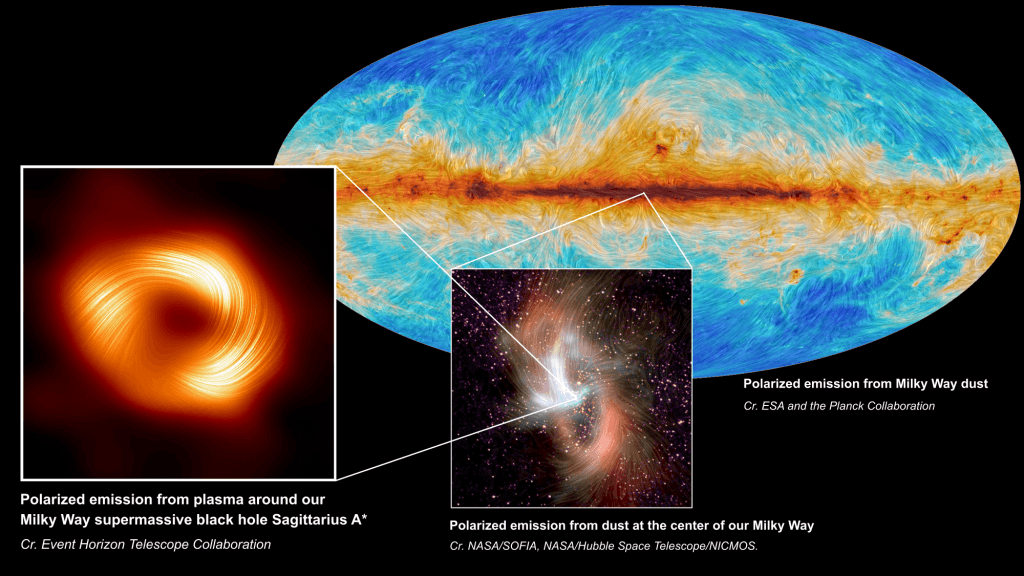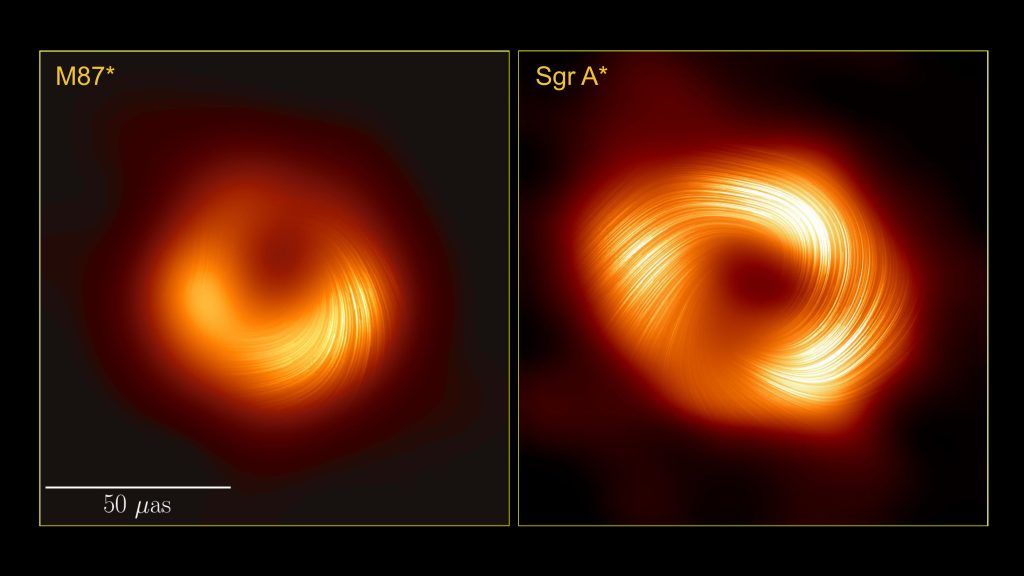Si vous avez déjà essayé de photographier un enfant d’âge préscolaire qui se déplace rapidement, vous avez alors vécu une expérience de ce que c’est que de prendre une photo du trou noir au centre de notre galaxie. Le maelström indiscipliné, que les astronomes appellent Sagittarius A* (SgrA*), se déplace et change d’heure en heure alors que du plasma chaud tourbillonne autour de lui. De plus, des couches gênantes de plasma interstellaire entre la Terre et le trou noir bloquent notre vue, ce qui rend difficile la capture d’une image claire.
Malgré les défis, les scientifiques ont réussi à prendre cette première photo, qu’ils ont dévoilée en 2022.
Aujourd’hui, de nouvelles images de SgrA* ont été publiées, révélant non seulement l’anneau de plasma, mais aussi les lignes de champ magnétique qui le façonnent et l’organisent. Les résultats ont été publiés dans deux articles de la revue The Astrophysical Journal Letters, l’un révélant les nouvelles observations et l’autre interprétant les données. Les nouvelles observations confirment nos meilleures théories sur la croissance et l’évolution des trous noirs supermassifs, fournissant une base empirique solide pour la science de l’évolution galactique et des environnements de gravité extrême.
Il a fallu faire preuve d’une grande ingéniosité pour y parvenir, et les scientifiques canadiens, dans le cadre de la collaboration mondiale Event Horizon Telescope (EHT), ont joué un rôle crucial pour y parvenir.
« SgrA* est comme un enfant frénétique », explique Avery Broderick, professeur associé à l’Institut Périmètre et à l’Université de Waterloo. « Mais nous avons réussi à surmonter les défis posés par sa variabilité, et les résultats sont vraiment passionnants. Nous voyons pour la première fois la structure invisible qui guide la matière dans le disque du trou noir et conduit le plasma vers l’horizon des événements, aidant ainsi le trou noir à grandir. »
Broderick et son équipe sont les experts à l’origine de THEMIS, un cadre d’analyse des données collectées par le télescope EHT. L’imagerie avec THEMIS a changé la donne dans l’astronomie des trous noirs, en apportant des solutions à deux défis importants auxquels les scientifiques étaient confrontés lorsqu’ils essayaient d’imager SgrA* avec confiance.
Tout d’abord, THEMIS offre un moyen d’évaluer de manière fiable la crédibilité de toute image donnée du trou noir. Le télescope EHT ne peut pas capturer toute la lumière de SgrA* : certaines lacunes doivent être comblées par extrapolation. Mais cela signifie qu’il existe plusieurs images possibles cohérentes avec les données. THEMIS permet de passer au crible ces possibilités. Il fonctionne comme suit : au lieu de réduire les options à une seule image, THEMIS explore toutes les images possibles, en donnant des probabilités précises pour savoir quelles caractéristiques sont réelles et lesquelles sont du bruit dans la machine. Ce faisant, THEMIS réduit le risque de mauvaise interprétation des données et fournit une méthode statistique fiable pour étudier les informations que SgrA* nous envoie de toute la galaxie.
Deuxièmement, THEMIS offre un moyen d’imager SgrA* même si le trou noir refuse de rester immobile. Le plasma tourbillonnant de SgrA* est en constante évolution, changeant sur de courtes échelles de temps. Grâce à THEMIS, les astronomes ont pu modéliser le « bruit » dans les données et en fournir une estimation, ce qui leur a permis de « l’annuler » pour produire une image claire et moyenne dans le temps de SgrA* malgré sa variabilité rapide.
Ces deux avancées combinées ont permis à l’équipe du télescope EHT d’interpréter de manière fiable ce qu’ils voient se produire autour de SgrA*, malgré la variabilité effrénée de l’anneau de plasma.
Qu’ont-ils donc découvert? Les nouveaux résultats révèlent de forts schémas de polarisation dans les signaux émis par SgrA*.
La polarisation – une propriété décrivant l’orientation des oscillations des ondes lumineuses – est le même principe que celui dont les lunettes de soleil tirent parti pour atténuer l’intensité en bloquant les ondes lumineuses orientées dans une ou plusieurs directions.
Les ondes que reçoit le télescope EHT de SgrA* se présentent principalement sous la forme de rayonnement synchrotron, c’est-à-dire d’émissions d’électrons de haute énergie qui contournent les lignes de champ magnétique du trou noir. Les émissions synchrotron ont tendance à être polarisées perpendiculairement au champ magnétique dont elles proviennent. En d’autres termes, en mesurant la polarisation, les scientifiques sont en mesure de mesurer la structure et la force des champs magnétiques de SgrA*.
« La lumière polarisée que nous voyons en provenance de SgrA* est frappante », explique Broderick. « Non seulement elle est hautement polarisée – trois fois plus que le trou noir au centre de la galaxie M87 – mais elle est également hautement organisée. Cette nouvelle image limite la densité du plasma en orbite autour de Sgr A* et révèle les champs magnétiques qui régissent son destin. »
Selon les meilleurs modèles d’évolution des trous noirs élaborés par les astronomes, les champs magnétiques du disque d’accrétion doivent être suffisamment puissants pour déplacer le plasma accrétant. Les nouveaux résultats de SgrA* (et ceux de son cousin beaucoup plus grand M87* auparavant) fournissent la première preuve observationnelle directe à l’appui de ces modèles : nous voyons ces trous noirs « manger » en temps réel.
Ces nouvelles recherches marquent une étape importante dans l’astronomie des trous noirs, racontant l’histoire de l’évolution des trous noirs et mettant en évidence le noyau indiscipliné de notre voisinage galactique.
À propos de l’IP
L'Institut Périmètre est le plus grand centre de recherche en physique théorique au monde. Fondé en 1999, cet institut indépendant vise à favoriser les percées dans la compréhension fondamentale de notre univers, des plus infimes particules au cosmos tout entier. Les recherches effectuées à l’Institut Périmètre reposent sur l'idée que la science fondamentale fait progresser le savoir humain et catalyse l'innovation, et que la physique théorique d'aujourd'hui est la technologie de demain. Situé dans la région de Waterloo, cet établissement sans but lucratif met de l'avant un partenariat public-privé unique en son genre avec entre autres les gouvernements de l'Ontario et du Canada. Il facilite la recherche de pointe, forme la prochaine génération de pionniers de la science et communique le pouvoir de la physique grâce à des programmes primés d'éducation et de vulgarisation.
Ceci pourrait vous intéresser




